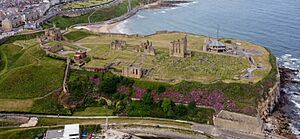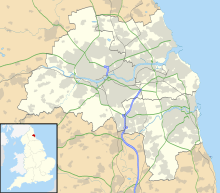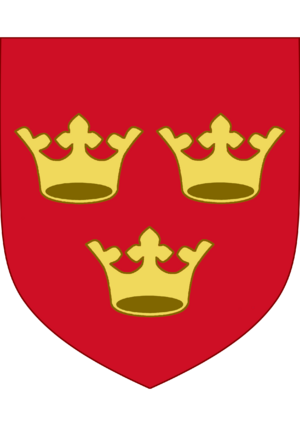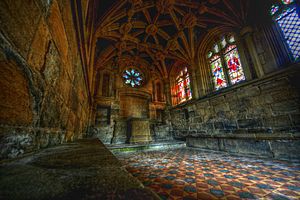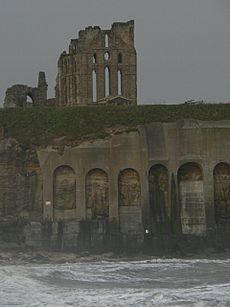Tynemouth Priory and Castle facts for kids
Tynemouth Priory and Castle is an amazing historic site. It sits on a piece of land that sticks out into the sea, right where the River Tyne meets the ocean at Tynemouth. Long ago, a medieval Benedictine priory (a type of monastery) stood here. It was protected by strong walls, tall towers, and a big gatehouse. The local area, North Tyneside, even has three crowns on its coat of arms. These crowns remember the three kings who were buried at the priory a very long time ago.
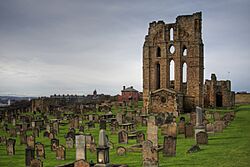
The remains of Tynemouth Priory
|
|
| Monastery information | |
|---|---|
| Order | Order of Saint Benedict |
| Mother house | St Albans Abbey |
| Dedicated to | St Oswine and the Virgin Mary |
| Architecture | |
| Status | Priory |
| Functional Status | Ruined |
| Heritage designation | Scheduled monument |
| Site | |
| Location | Tynemouth, Tyne and Wear, England |
| Coordinates | 55°01′03″N 1°25′08″W / 55.0175°N 1.4189°W |
| Public access | Yes |
Contents
Tynemouth Priory: A Look Back in Time
Early Days of the Priory
People lived on this promontory (the land sticking out) a very long time ago. We know this from traces of two round wooden houses. One was from the British Iron Age, about 200 years before the Romans arrived in Britain. The other was from the Roman period in the 2nd century.
A monastery was likely started here by one of the Anglian kings of Northumbria. Old stories say it began in the mid-7th century. This was when King St Oswine was buried here by his killer, King Oswiu. Oswiu started the monastery as a way to show he was sorry.
A writer named Bede mentioned an abbey (another type of monastery) at this spot. By 792, it was important enough to be the burial place for King Osred II. This made him the second king buried at Tynemouth.
The monastery faced many attacks from Vikings in the 9th century. It was destroyed in 875. No buildings from this time remain, but pieces of Anglo-Saxon crosses and traces of five rectangular wooden buildings have been found.
In the mid-11th century, there was a church dedicated to St Mary here. William the Conqueror destroyed this church during his "Harrying of the North."
In 1065, a body believed to be St Oswine's was found at the ruined monastery. In 1083, a monk named Turchil restarted the monastery. However, in 1090, Robert de Mowbray, a powerful Earl, gave his lands around Tynemouth to St Albans Abbey. This started a long argument between the monks of Durham and St Albans over who controlled Tynemouth.
Soon after, work began on a new church. It was dedicated to St Oswine and the Virgin Mary. St Oswine's shrine became a popular place for people to visit.
In 1093, Malcolm III, the King of Scotland, died in battle. He became the third king buried at Tynemouth. Later, his son, Alexander I, moved his father's body to another abbey.
On August 20, 1110, St Oswine's shrine was officially moved to the new church at Tynemouth. This meant the east end of the church was finished. In 1150, a fire destroyed some of the monastery buildings.
The Priory's Golden Age
The argument between the monks of Durham and St Albans ended in 1174. Tynemouth Priory remained connected to St Albans Abbey. Around this time, the priory gained many rights and a lot of land. King Richard I confirmed these in 1189.
The large monastic estate became known as the Liberty of Tynemouth. The prior (the head of the priory) and the monks made money from rents, farm products, and coal. This new wealth led to a period of building and repairs from 1190 to 1260. The main church areas were rebuilt. St Oswine's shrine was decorated with gold and jewels. The church's front was extended, and windows were fixed.
In the early 13th century, the prior started developing North Shields as the priory's port. This caused problems with the people of Newcastle. They used to control all the trade on the river. In 1270, the mayor of Newcastle led armed men and burned the new fishing village.
The priory wanted to be independent from St Albans. So, the abbot of St Albans, along with Newcastle's mayor, convinced King Edward I to stop Tynemouth's trade in 1290. However, King Edward I and Margaret of France visited the priory often. They had a private prayer room built there. Because of the monks' kindness, the priory's trading rights were given back.
Adam FitzRoy, a son of King Edward II, died on September 18, 1322. He was buried at Tynemouth on September 30, 1322.
From the 13th century, St Albans often sent monks who caused trouble to Tynemouth as punishment. One such monk wrote a letter in the mid-14th century. It's the first known written description of the priory. He described it as being on a high rock, surrounded by the sea on all but one side. He mentioned the narrow gate, the loud waves, and the sea fog. He also talked about shipwrecks and the "grey birds" that ate the drowned. He said the sea air ruined fruit trees. But he also said the church was "wondrously beautiful" and held the "magnificently decorated" shrine of St Oswine. He said St Oswine protected people who came to him for help.
The church with the shrine was the Lady chapel, built before 1336. The Percy chapel was added in the mid-15th century.
The End of the Priory
In the early 16th century, Tynemouth finally became independent from St Albans. This was allowed by Thomas Wolsey. But soon after, in January 1539, King Henry VIII closed down the priory. He took all its lands and destroyed St Oswine's shrine. This was part of the Dissolution of the monasteries, which brought the priory to an end.
Tynemouth Castle: A Stronghold by the Sea
| Tynemouth Castle | |
|---|---|
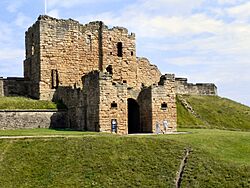
The remains of Tynemouth Castle
|
|
| Type | Gatehouse |
| Site information | |
| Owner | English Heritage |
| Open to the public |
Yes |
| Condition | Ruined |
| Site history | |
| Built | 13th-14th century |
| Materials | Sandstone |
| Events | First War of Scottish Independence, English Civil War |
Early Defenses
In 1095, Robert de Mowbray rebelled against King William II. When the king attacked Mowbray's castle, Mowbray and 30 followers hid in Tynemouth. They held out for six days before being captured. This suggests the monastery already had some defenses, perhaps a small castle.
When King Edward I invaded Scotland in 1296, the prior was given permission to build strong walls around the monastery. These walls were built on an earth mound that crossed the land. They might have been part of older defenses from the Norman times or even the Iron Age. The walls once surrounded the entire monastery. They had towers like Whitley Tower and East Mount Tower. These stone walls were an upgrade to defenses that had been there since the time of King Henry II.
In 1312, King Edward II hid in Tynemouth Castle with his friend Piers Gaveston. They later escaped by sea to another castle, even though Edward's wife, Isabella, begged him to stay.
After his victory in 1314, Robert the Bruce attacked Tynemouth. But the castle was successfully defended by 80 soldiers. In 1318, the king appointed someone to look after the priory's defenses. In February 1390, King Richard II, John of Gaunt, and Henry Percy all gave money for Tynemouth's defenses. Soon after, a large gatehouse began to be built in the middle of the earth mound. It was finished by the early 15th century.
Royal Control and Later Use
The castle remained under royal control after the priory closed. This was because it was a very important strategic location. New artillery defenses were built starting in 1545. Experts like Sir Richard Lee and Italian engineers helped. The old medieval castle walls were updated with new places for cannons.
Henry Percy, 9th Earl of Northumberland was born at the castle in 1564. His father, the 8th Earl, was in charge of the castle at that time.
In May 1594, two people who had stolen jewels from the court of Anne of Denmark were captured at Tynemouth Castle. They were held there for five weeks before being sent back for trial.
William Selby became the keeper of Tynemouth Castle in December 1606. An inventory was made of the weapons at the castle. Selby wrote that the living quarters were not fit to live in and the guns were not set up. His job included keeping a light burning for ships.
Tynemouth's Changing Roles
The Lighthouse Story
For a long time, a light was kept burning on top of one of the priory church's turrets. This was a coal-fired brazier (a metal basket for burning coal). It helped guide ships safely past the coast. We don't know exactly when this started, but a record from 1582 mentions "keeping a continuous light at night at the east end of the church of Tynemouth castle."
The Governor of Tynemouth Castle was responsible for keeping the light going. They were allowed to collect fees from passing ships.
In 1559, the stairs to the turret collapsed, so the fire couldn't be lit. In 1665, a new lighthouse was built on the headland within the castle walls. It used stone from the priory. This lighthouse was rebuilt in 1775. At first, it also burned coal. But in 1802, an oil-fired light was installed.
In 1841, the lighthouse was sold to Trinity House, London, which manages lighthouses. When a new lighthouse was built at Souter Point in 1871, the Tynemouth light changed to a revolving red light. It kept working until 1898. Then, St. Mary's Lighthouse was built further north, and Tynemouth Castle Lighthouse was taken down.
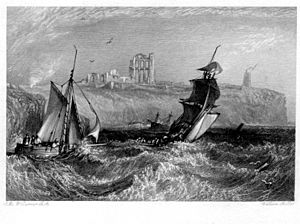
Coastal Defense and Coastguard
At the end of the 19th century, the castle became a barracks for soldiers. Several new buildings were added.
In 1930, the castle was taken over by the Office of Works after a fire. Many of the newer buildings were removed. The castle was very important during World War II. It was used as a coastal defense to protect the mouth of the River Tyne. It was also heavily bombed in 1941. Military structures stayed there until 1956 when the army left.
Today, you can visit the restored parts of the coastal defenses. These include a guardroom and the main armory. You can see how weapons were stored and handled safely.
More recently, the site had modern buildings for Her Majesty's Coastguard. A new coastguard station was built in 1980 and opened by Prince Charles. However, it closed in 2001.
Tynemouth Today
The gatehouse is the only part of the medieval defenses that is still standing. The remaining parts of the priory, like the east end wall and its tall, narrow windows, are examples of early Gothic architecture. The later Percy chapel is still completely intact.
Much of the original walls, which were about 975 meters long, still remain. The promontory was once completely surrounded by a wall and towers. However, the north and east walls fell into the sea. Most of the south wall was taken down. The west wall and a section of the south wall are still in good condition. Of the modern military buildings, only the Warrant Officer's house and gun emplacements remain.
Tynemouth Castle and Priory is now looked after by English Heritage. Visitors can pay a fee to explore this amazing historical site.
Images for kids
See also
- List of monastic houses in England
- List of castles in England
- Our Lady and St Oswin's Church, Tynemouth


